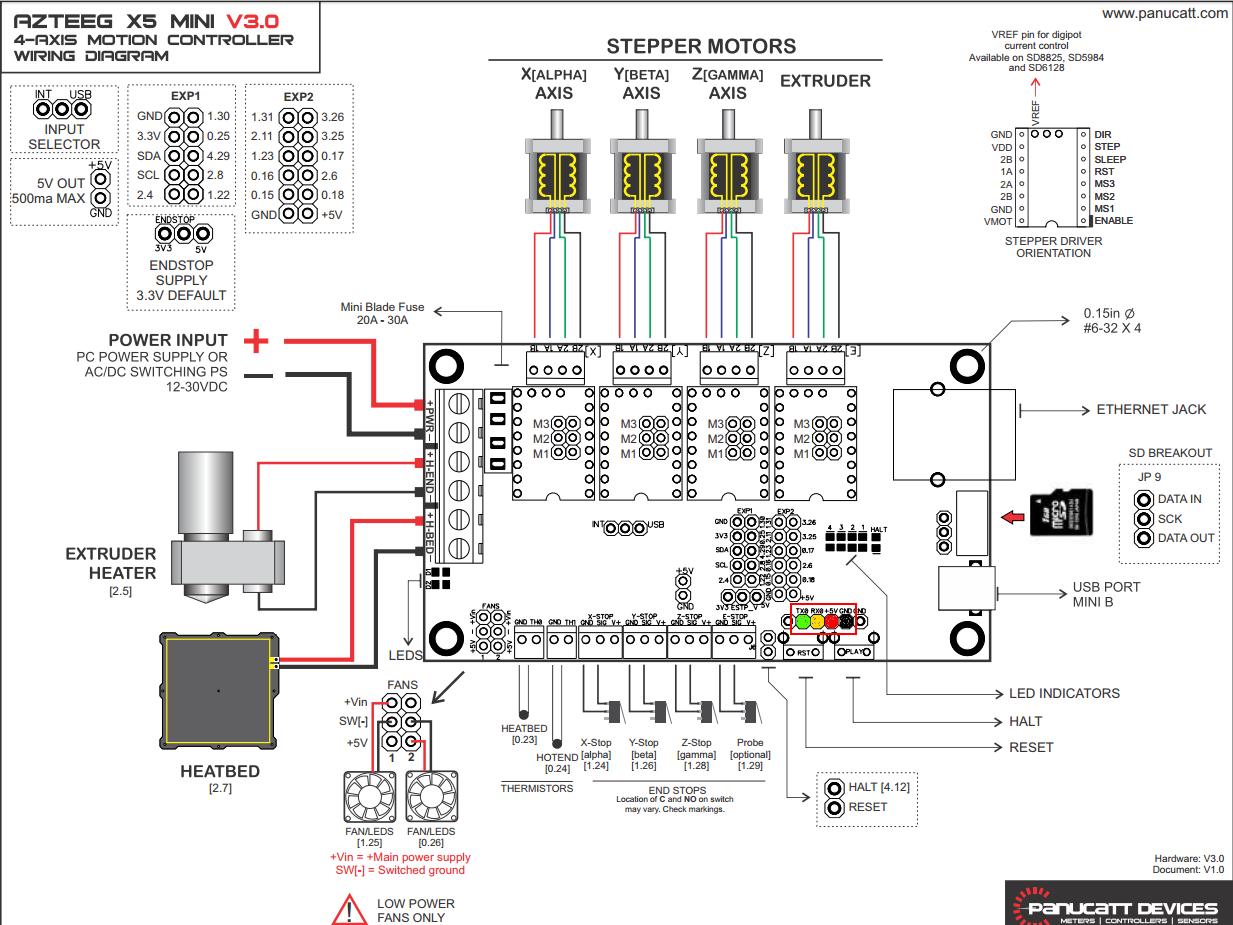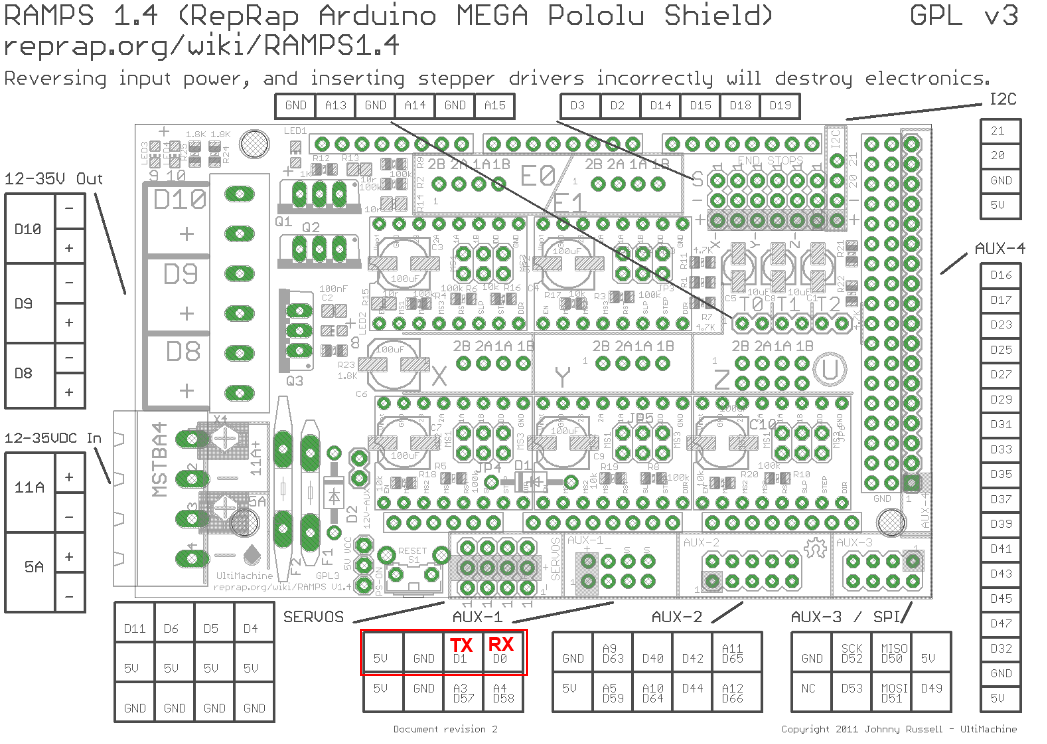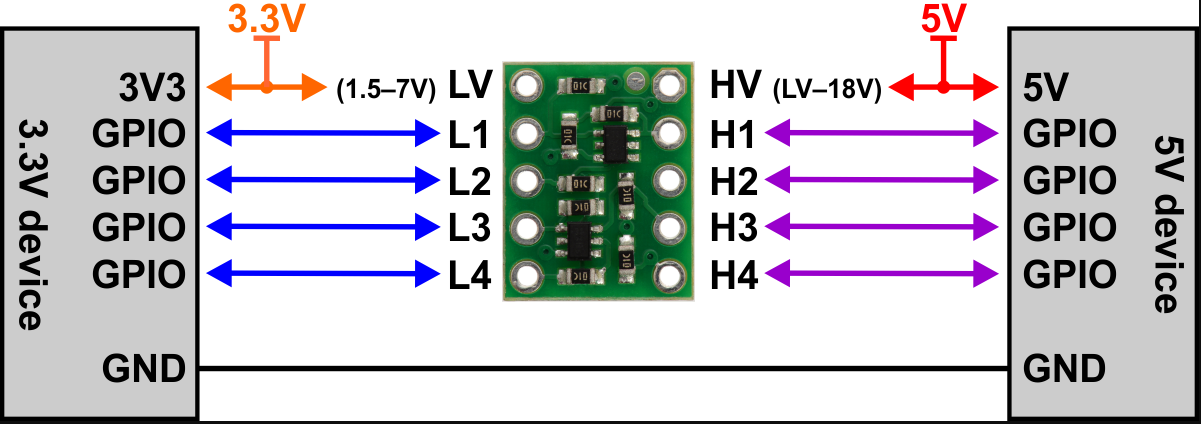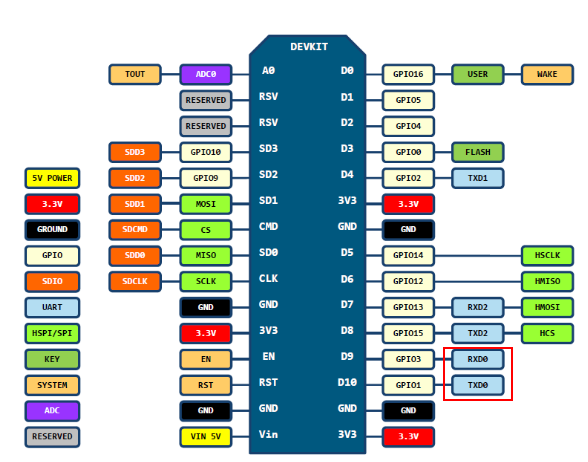16 KiB
Hardware connection
If your motherboard doesn't support wifi, this repo will help you add an ESP board flashed with ESP3D firmware. The ESP32 or ESP8266 MCU on ESP board supports wifi and will connect to your printer using a serial UART port thus acting as a wifi to UART bridge. The board needs to be programmed and connected properly to your printer to work. The printer motherboard will also need to be reprogrammed to enable the UART port that will be used with ESP board.
Connection between ESP and printer board needs 4 wires:
- ESP Tx needs to connect to Rx on MCU of printer board.
- ESP Rx needs to connect to Tx on MCU of printer board.
- You also need to power supply ESP board with with GND and 3V3 or 5V.
Connecting ESP board (ESP MCU is 3.3V) to 5V printer board
Disclaimer : this wiki is for reference - you are responsible of your board supporting or not 5V, we are not responsible for any damage of wrong wiring.
ESP32 and ESP8266 MCU are supporting only 3V3. Power supply them with 5V will likelly fry them immediatelly. As MCU is supplied at 3.3V, Tx and Rx signals will be at 3.3V even when board is supplied with 5V. Wether Rx pin is supporting 5V is controversial so we will keep on the safe side and only take datahseet as reference. It's not recommended to have any signal (including Rx) be higher than power supply (3.3V here).
There are several points to take care. One should check that
- MCU1 Tx voltage is lower than MCU2 supply voltage
- Voh_min of Tx is higher than Vih_min of Rx (to check both ways)
- Vol_max of Tx is lower than Vil_max of Rx (to check both ways)
1 is mandatory and resistor voltage divider bridge or level shiffter is recommended
2 & 3 are not destructive there is just a slight risk signals are not read correctly. But it will work in most case as the limit values given by datasheets are rarelly met in mild conditions (using near 25°C and low current flowing from Tx to Rx)
For the divider bridge a value of R1=1k and R2=2.2k will be fine. You could also use 10k and 22k or anything near a factor 2.

click to enlarge
Connection diagrams for some printers and ESP boards
- Printer motherboards
- Anet A8 boards
- Anycubic i3 mega - Trigorilla 8bit board
- AZSMZ LCD board
- AZSMZ-mini board
- Azteeg X5 mini board
- BIQU KFB2.0 board
- Creality CR10 Ender 3 board
- Creality Ender 4 board
- Davinci 1.0/2.0 board
- Davinci 1.0A board
- MKS boards
- MKS Smoothieware board
- RADDS board
- RAMPS 1.4/Re-ARM board
- Smoothieboard board
- Weedo Tina2 board
- For printer boards not listed here
- ESP boards
Printer motherboards
Anet A8 boards
Anet boards up to v1.5
Step 1
You will also have to unsolder the resistors R52 and R53 – they are zero ohm resistors, and serve no other purpose than connecting the atmega chip directly to the onboard USB to UART converter (the CH340 chip). Do it VERY careful – you don’t want to damage your board. If you don’t feel confident – don’t do it.

click to enlarge
Step 2
Now prepare the printer’s motherboard. It requires a simple modification, that does not interfere with it’s operation afterwards – just solder 3 pin x 2 row male header on J8, and add 2 jumpers (or jumper wires) as shown on the picture:

click to enlarge
Step 3
Connect the ESP to J3 repsecting pinout

click to enlarge
| ESP | J3 |
|---|---|
| Tx | Rx |
| Rx | Tx |
| GND | GND |
| VCC | 3.3V |
| CH_PD | 3.3V |
For more Info check http://lokspace.eu/anet-a8-wifi-mod/
For connecting version 1.7 Anet boards
Unlike older boards this board does not require you to remove any resistors.
You will have to solder two wires from number 9 and number 10 its recommender to connect these to pin 1 and 2 of J3 connector.

click to enlarge
Anycubic i3 mega - Trigorilla 8bit board
To connect the ESP12e to the UART0. (Credits:https://www.lesimprimantes3d.fr/forum/profile/197-murdock/).
(Green = RX, Blue = TX)
5V (buck to 3.3v if directly connect to ESP - most development ESP boards already have this voltage limited built-in - but check!) and GND can be taken from the AUX3 exposed connector.
UART0 is normally used by USB port so don't use both together - so this hack piggybacks on that same port at UART level.
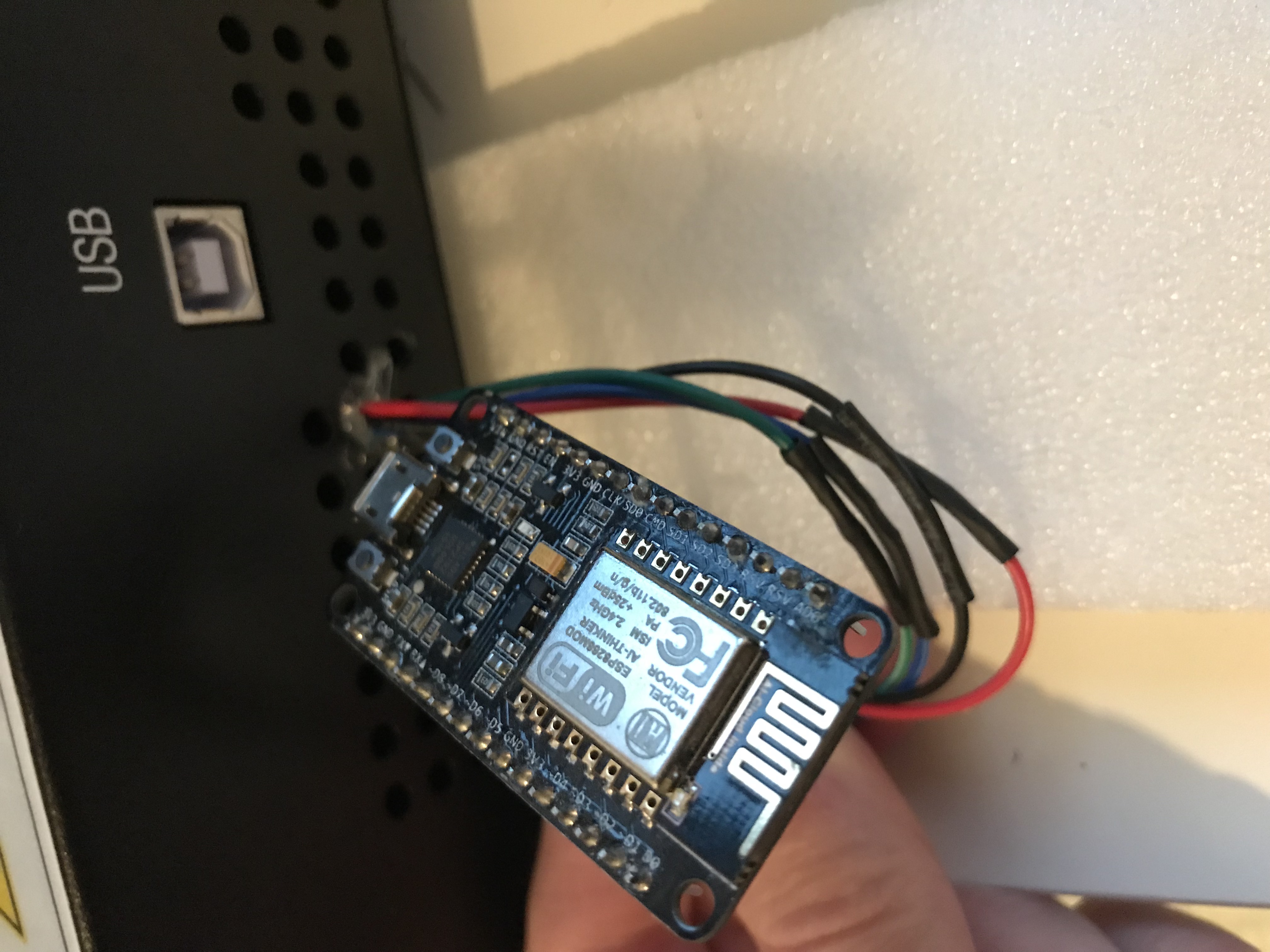
click to enlarge
AZSMZ LCD board

click to enlarge
AZSMZ-mini board

click to enlarge
If you don't have the soldering skills to grab the connectors from the unpopulated ethernet connection, you can also get 3.3v and GND from the ISP header (bottom left on the diagram above).
Azteeg X5 mini board
click to enlarge
BIQU KFB2.0 board
all in one Ramps1.4/Mega2560 R3 controller based

click to enlarge
Creality CR10 Ender 3 board
For the Sanguino based CR-10 and Ender printers you will need to solder to any of the via circled (can also be done in the backside of board), or to the legs of the Arduino or ftdi. Connect TX from the board to RX of Wemos D1 mini and RX from board to TX of Wemos D1 mini. 5v and GND are located in the six pin header next to the LCD connector.
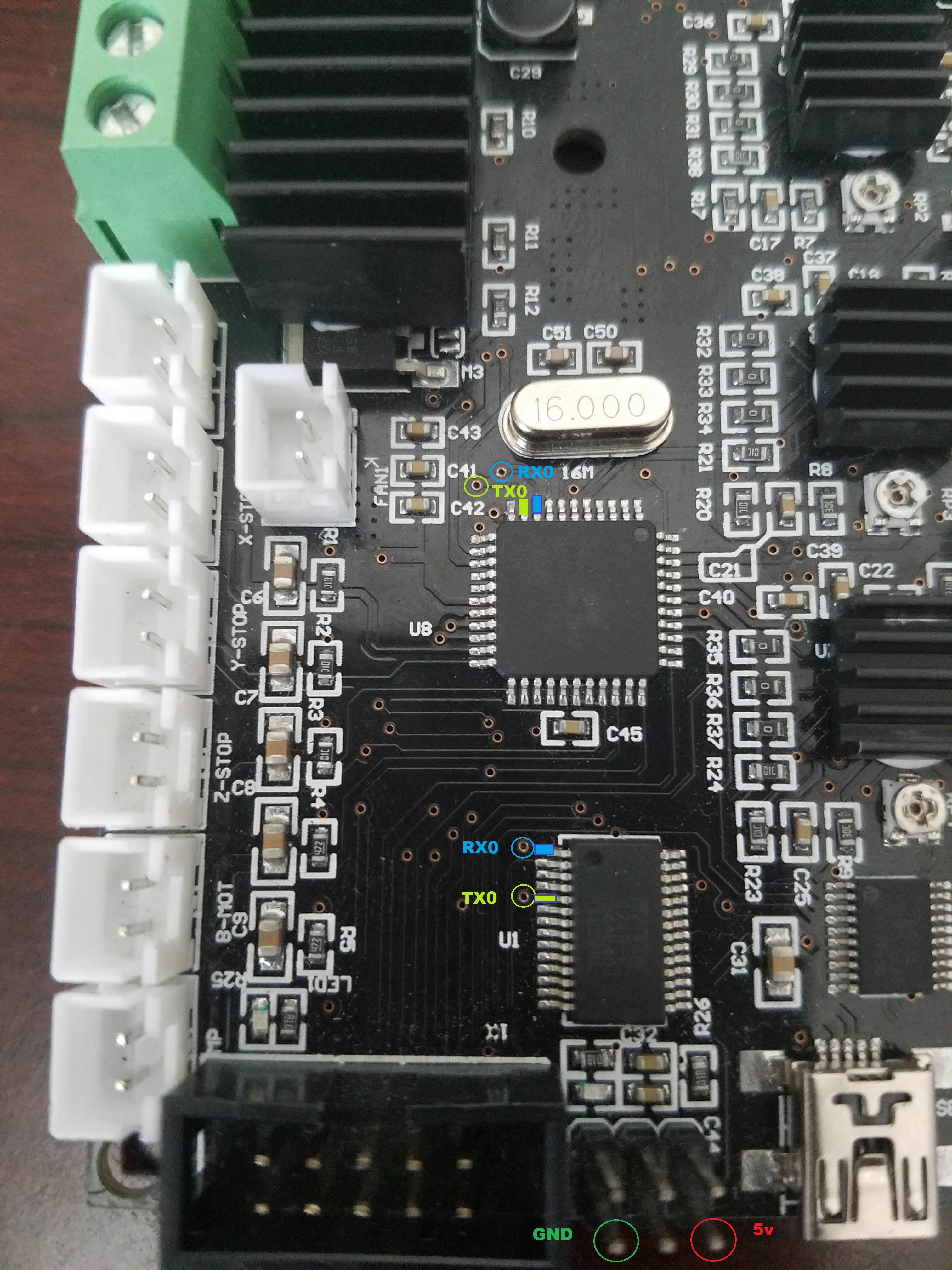
click to enlarge
Since soldering might be difficult because the solder points are so close to each other, another option is to scrape off the insulation from the traces on the backside and solder there. Be extra careful not to scrape the surrounding ground plane. You need suitable fine scraping tools for this. The picture below shows an Ender-2 PCB.
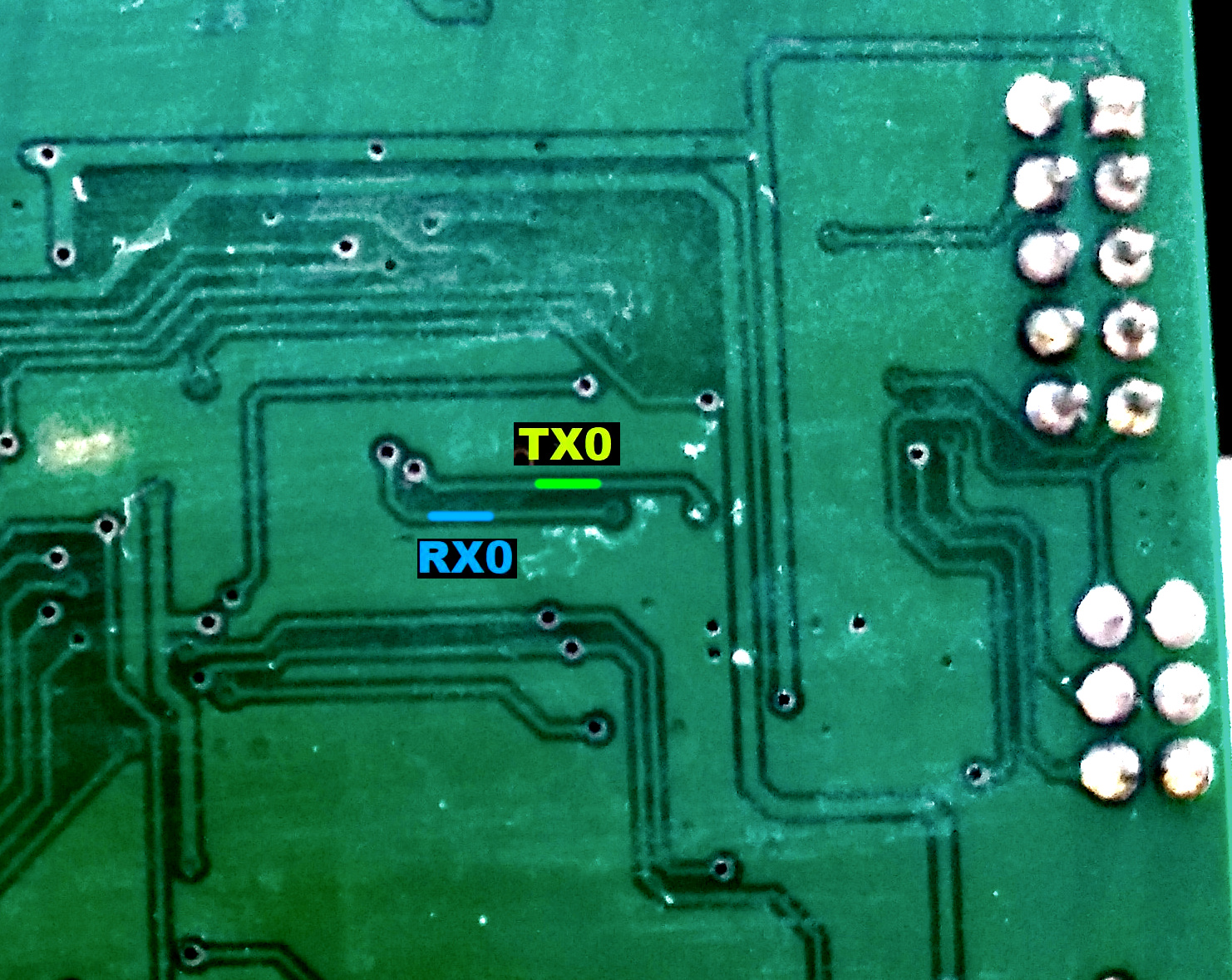
click to enlarge
Creality Ender 4 board
You will need to solder to small circle, or to the legs of the ATmega2560 (RXD0 pin 2, TXD0 pin 3)

click to enlarge
Davinci 1.0/2.0 board

click to enlarge

click to enlarge

click to enlarge

click to enlarge

click to enlarge
Davinci 1.0A board

click to enlarge

click to enlarge

click to enlarge
Alternate Module placement for increased WiFi range (outside metal chassis, antenna has vertical polarization)

click to enlarge
MKS boards
To connect the ESP3D to the MKS GEN v1.2 (but the v1.3 and above 1.4 is the most used today).
I have used an ESP12E with the standard schematics, with one important difference, the two resistor connected to the RX pin are substituted by a 1N4148 diode, like in the Adafruit Huzzah board.

click to enlarge
ESP12E is connected to the AUX1
ESP12E RX is connected to the pin NEAR GND of the upper row (Marked TXD on pinout.)
ESP12E TX is connected to the adiacent pin at the end of the upper row (Marked RXD on pinout.)

click to enlarge
MKS Smoothieware board

click to enlarge
RADDS board

click to enlarge

click to enlarge
RAMPS 1.4/Re-ARM board
Ramps 1.4 can be used on Arduino Mega (repetier/marlin) and Re-ARM for ramps boards (smoothieware/marlin)
click to enlarge
Alternative pins if use Re-ARM (J4/UART port)

click to enlarge
Smoothieboard board

click to enlarge
Weedo Tina2 board
This printer is also brand labelled as Monoprice MP cadet 3D printer

click to enlarge
In marlin this connection is serial port 3.
Note the Mega2560 is 5V powered and ESP is 3V3 powered.
For printer boards not listed here
Vast majority of printers have an USB port that is converted to UART before going to MCU. Many printers also have additional (unused) UART port you can use. When possible, always use the additional port for connecting ESP to printer board. When no additional UART port is available you might use the Tx and Rx lines between USB/UART converter and MCU but it's recommended to cut (in a reversible way) the line to USB/UART converter to avoid conflicts.
If the board is ATmega based the simplest way to find a usable UART port for the ESP is to open ATmega datasheet.
ESP boards
ESP-01
- Use GPIO2 to ground to reset all settings in hard way - 2-6 sec after boot / not before!! Set GPIO2 to ground before boot change boot mode and go to special boot that do not reach FW. Currently boot take 10 sec - giving 8 seconds to connect GPIO2 to GND and do an hard recovery for settings
- Use GPIO0 to ground to be in update mode
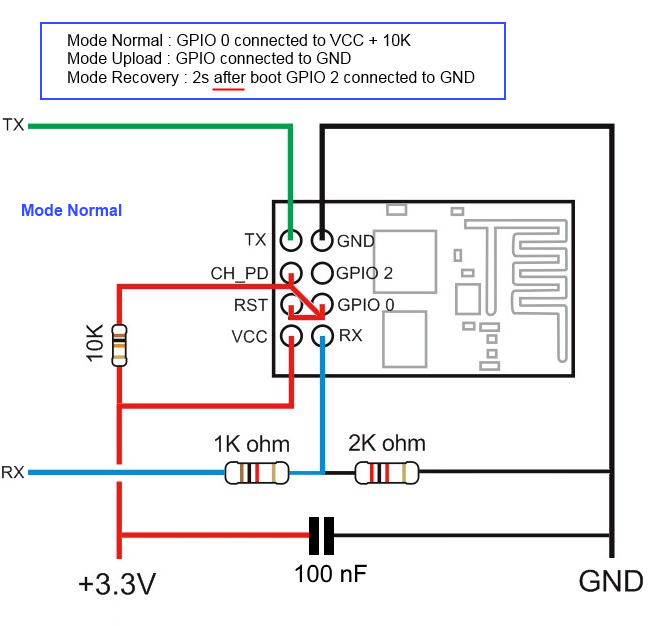
click to enlarge
ESP-01 serial wifi module
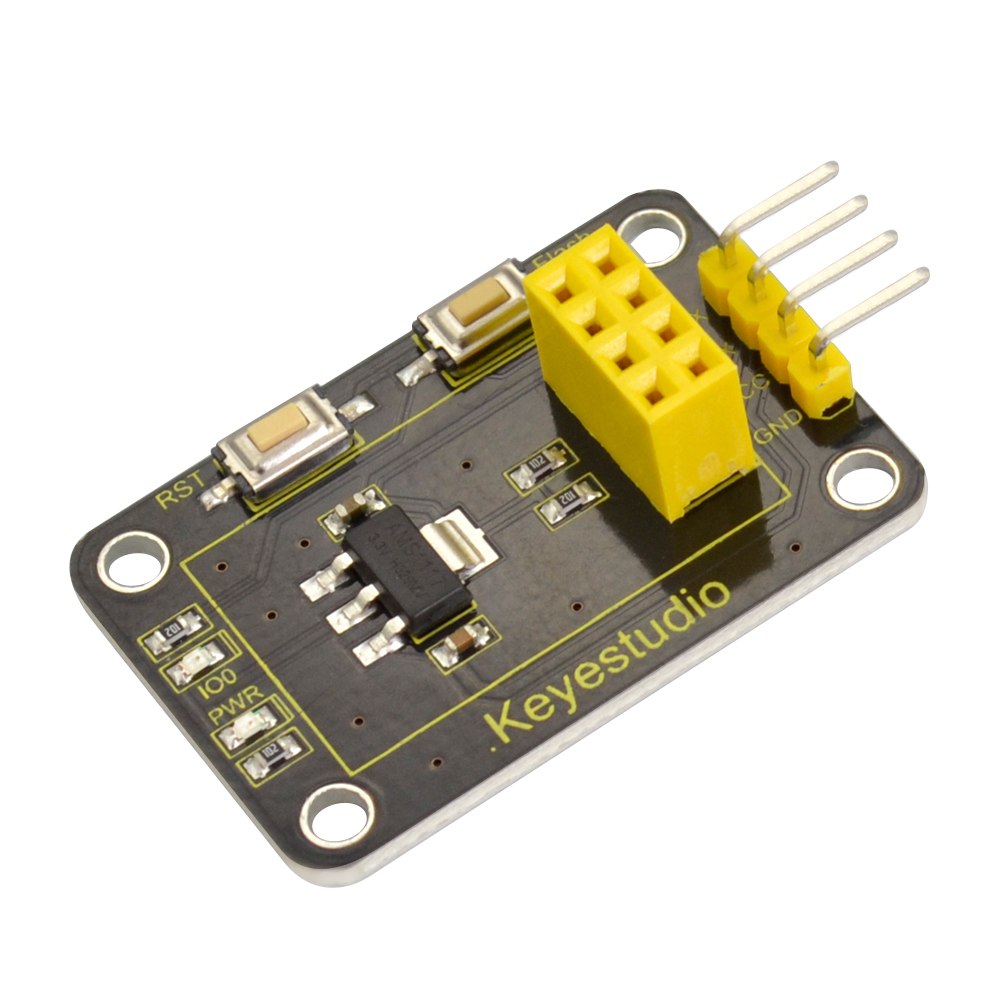
click to enlarge
more info about the Breakout PCB: https://www.keyestudio.com/keyestudio-esp-01s-wifi-to-serial-shield-module-for-arduino-esp8266-wifi-p0499-p0499.html
ESP-12E/F
ESP need 3.3v, it is not 5v tolerant, if printer board use more than 3.3V like 5V on ramps.

click to enlarge
you can also use Logic LevelConverter Bi-Directional
click to enlarge
In order to flash some ESP12E/F boards via their UART interface, the following pins need to be connected:
- VCC to GPIO2
- GND to GPIO0
This has been tested with ESP-12-E boards labeled "ESP8266 For ESP3D FYSETC.COM"
ESP 12F serial wifi module
We can flash our loved ESP3D to cheap ESP-12F based serial wifi module (eg from aliexpress ). It contains built in 2-way levelshifter/bi-directional logic level converter. So we can power and use via 5V uart from the 3d printers' motherboard.
- We need to manualy ground the
IO0while powering up to start in flash mode while powering up (there is no switch for that, neither for reset)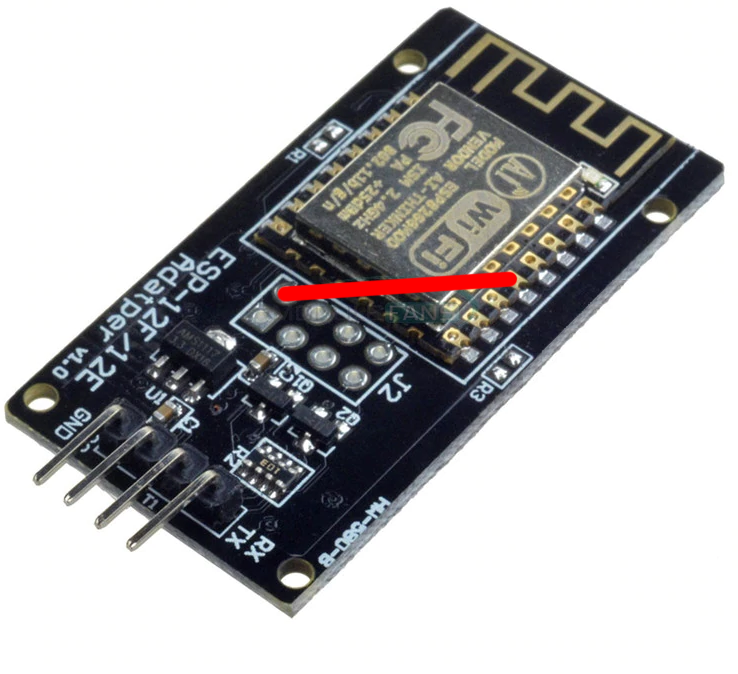
click to enlarge
- I used FTDI adapter as usb2serial
- We have to see in console/serial monitor boot mode is (1,7).
- baudrate: 74880
rst cause:2, boot mode:(3,7)
- Then flash like other esp based board for esp3d
- check flash size. Mine has 4M
- Install
ESP32-Cam
Once the board is programmed, the wiring to the printer board should be like this:

click to enlarge
Note: 5V is power supply input and 3V3 is output from regulator. UART Tx and RX signals will be 3.3V
NodeMCU V2/V3
click to enlarge
Sonoff

click to enlarge
Relay is connected by GPIO12, it can be handled using ESP201 command:
*Get/Set pin value
[ESP201]P<pin> V<value> [PULLUP=YES RAW=YES]
if no V<value> get P<pin> value
if V<value> 0/1 set INPUT_PULLUP value, but for GPIO16 INPUT_PULLDOWN_16
GPIO1 and GPIO3 cannot be used as they are used for serial
if PULLUP=YES set input pull up, if not set input
if RAW=YES do not set pinmode just read value
So [ESP201]P12 V0 should be off and [ESP201]P12 V1 should be on
Wemos D1 mini
Connection with logic level conveter:

click to enlarge
example:

click to enlarge
printed cases:

